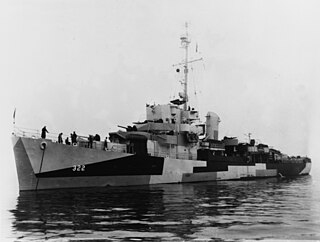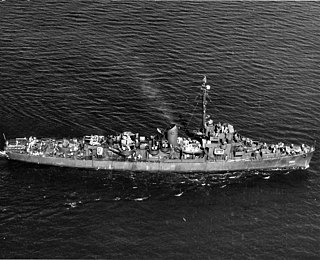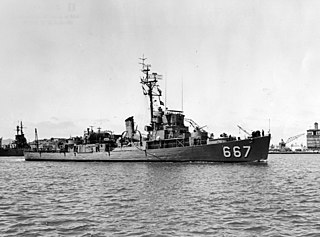
USS Breckinridge (DD–148) was a Wickes-class destroyer in the United States Navy during World War II, later reclassified as AG-112. She was named for Ensign Joseph Breckinridge.

USS Preston (DD-795), a Fletcher-class destroyer, was the sixth ship of the United States Navy to be named for Lieutenant Samuel W. Preston (1840–1865).

USS Melvin (DD-680) was a Fletcher-class destroyer and the second ship of the United States Navy to be named for Lieutenant, junior grade John T. Melvin (1887–1917), who was killed on 5 November 1917 while serving on the USS Alcedo in World War I and is recognized as the first American naval officer to die in that war.

USS Finch (DE-328) was an Edsall-class destroyer escort in the service of the United States Navy from 1943 to 1946 and from 1956 to 1969. From 1951 to 1954, she was loaned to the United States Coast Guard where she served as USCGC Finch (WDE-428). She was scrapped in 1974.

USS Clarence K. Bronson (DD-668) was a Fletcher-class destroyer of the United States Navy.

USS Monssen (DD-798) was a Fletcher-class destroyer of the United States Navy, the second Navy ship named for Lieutenant Mons Monssen (1867–1930), who was awarded the Medal of Honor for putting out a fire in a magazine on Missouri.

USS Durant (DE-389/WDE-489/DER-389) was an Edsall-class destroyer escort in the United States Navy, which served briefly in the United States Coast Guard.

USS Savage (DE-386) was an Edsall-class destroyer escort built for the United States Navy during World War II.

USS Martin (DE-30) was an Evarts-class destroyer escort constructed for the United States Navy during World War II. The ship was promptly sent off into the Pacific Ocean to protect convoys and other ships from Japanese submarines and fighter aircraft. The vessel entered service in 1943 and spent its entire career in the Pacific Ocean. Following the surrender of Japan, Martin returned to the United States and by the end of 1945, was slated for scrapping, which began in 1946.

USS Harveson (DE-316) was an Edsall-class destroyer escort built for the U.S. Navy during World War II. She served in the Atlantic Ocean the Pacific Ocean and provided destroyer escort protection against submarine and air attack for Navy vessels and convoys.

USS Kretchmer (DE-329) was an Edsall-class destroyer escort built for the U.S. Navy during World War II. She served in the Atlantic Ocean and the Pacific Ocean and provided destroyer escort protection against submarine and air attack for Navy vessels and convoys.

USS Kirkpatrick (DE-318) was an Edsall-class destroyer escort built for the U.S. Navy during World War II. She served in the Atlantic Ocean the Pacific Ocean and provided destroyer escort protection against submarine and air attack for Navy vessels and convoys. Post-war, she was converted to a radar picket ship to support the DEW Line.

USS Newell was an Edsall-class destroyer escort built for the U.S. Navy during World War II. She served in the Atlantic and Pacific Oceans and provided destroyer escort protection against submarine and air attack for Navy vessels and convoys. Post war, she served in various capacities before being finally decommissioned.

USS Koiner (DE-331) was an Edsall-class destroyer escort built for the U.S. Navy during World War II. She served in the Atlantic Ocean and the Pacific Ocean and provided destroyer escort protection against submarine and air attack for Navy vessels and convoys. Post-war, she was loaned to the U.S. Coast Guard, and also reclassified as a radar picket ship.

USS Price (DE-332) was an Edsall-class destroyer escort in service with the United States Navy from 1943 to 1947 and from 1956 to 1960. She was scrapped in 1975.

USS Ramsden (DE-382) was an Edsall-class destroyer escort built for the U.S. Navy during World War II. She served in the Atlantic Ocean and the Pacific Ocean and provided destroyer escort protection against submarine and air attack for Navy vessels and convoys. Post-war, she performed other tasks with the U.S. Coast Guard and with the U.S. Navy as a radar picket ship.

USS Rhodes (DE-384) was an Edsall-class destroyer escort in service with the United States Navy from 1944 to 1946 and from 1955 to 1963. She was scrapped in 1975.

USS Chambers (DE-391) was an Edsall-class destroyer escort in service with the United States Navy from 1943 to 1946 and from 1955 to 1960. From 1952 to 1954, she was loaned to the United States Coast Guard where she served as USCGC Chambers (WDE-491). She was finally scrapped in 1975.

USS Raymond (DE-341) was a John C. Butler-class destroyer escort acquired by the U.S. Navy during World War II. The purpose of the destroyer escort was primarily to escort and protect ships in convoy, in addition to other tasks as assigned, such as patrol or radar picket. Post-war, she returned home with five battle stars to her credit, including credit for her striking a Japanese cruiser with her 5-inch (127 mm) guns during the Battle off Samar. The destroyer escort was named for Reginald Marbury Raymond, who was killed by enemy gunfire on 30 April 1943 aboard USS Scorpion.

USS Wiseman (DE-667) was a Buckley-class destroyer escort in service with the United States Navy for several periods between 1944 and 1973. She was scrapped in 1974.




















